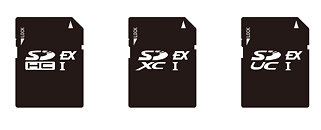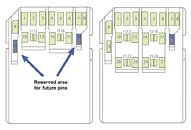- Joined
- Oct 9, 2007
- Messages
- 47,427 (7.51/day)
- Location
- Hyderabad, India
| System Name | RBMK-1000 |
|---|---|
| Processor | AMD Ryzen 7 5700G |
| Motherboard | ASUS ROG Strix B450-E Gaming |
| Cooling | DeepCool Gammax L240 V2 |
| Memory | 2x 8GB G.Skill Sniper X |
| Video Card(s) | Palit GeForce RTX 2080 SUPER GameRock |
| Storage | Western Digital Black NVMe 512GB |
| Display(s) | BenQ 1440p 60 Hz 27-inch |
| Case | Corsair Carbide 100R |
| Audio Device(s) | ASUS SupremeFX S1220A |
| Power Supply | Cooler Master MWE Gold 650W |
| Mouse | ASUS ROG Strix Impact |
| Keyboard | Gamdias Hermes E2 |
| Software | Windows 11 Pro |
The SD Association announced today the SD 8.0 Specification for SD Express memory cards receives even faster transfer speeds by using the popular PCI Express (PCIe ) 4.0 specification delivering a maximum of nearly 4 gigabytes per second (GB/s) data transfer rate. These full sized cards continue to use the NVMe Express (NVMe ) upper layer protocol enabling advanced memory access mechanism. As always SD Express memory cards using SD 8.0 specification maintain backward compatibility.
"SD Express' use of even faster PCIe and NVMe architectures to deliver faster transfer speeds creates more opportunities for devices to use SD memory cards," said Mats Larsson, Senior Market Analyst at Futuresource. "This combination of trusted and well-known technologies makes it easier for future product designs to leverage the benefits of removable storage in new ways."


SD Express gigabyte speeds bring new storage opportunities for devices with demanding performance levels, across a variety of industries. The cards can move large amounts of data generated by data-intense wireless or wired communication, super-slow motion video, RAW continuous burst mode and 8K video capture and playback, 360 degree cameras/videos, speed hungry applications running on cards and mobile computing devices, ever evolving gaming systems, multi-channel IoT devices and automotive to name a few. SD Express will be offered on SDHC, SDXC and SDUC memory cards.
"By dramatically increasing the speeds for SD Express we're giving device manufacturers and system developers more storage choices," said Hiroyuki Sakamoto, SDA president. "SD 8.0 may open even more opportunities for extra high performance solutions using removable memory cards."
"PCI-SIG is pleased to see that SDA is continuing to adopt even faster PCIe technology configurations using PCIe 4.0 interface and dual lanes for one of the top leading removable memory cards - SD," said Al Yanes, PCI-SIG president and chairman. "PCIe specification conformance tests are available today by major test vendors, offering a significant advantage for any new PCIe technology adopter."
"NVMe is the industry-recognized performance SSD interface from the client to the datacenter, shipping in millions of units," said Amber Huffman, NVM Express Inc. president. "Consumers will benefit by SD Association continuing the adoption of the NVMe base specification for their latest SD Express cards."
SD Express uses the well-known PCIe 4.0 specification and the latest NVMe specification (up to version 1.4) defined by PCI-SIG and NVM Express, respectively. SD 8.0 specification provides two transfer speed options for SD Express memory cards. The two transfer speeds are accomplished by supporting either PCIe 3.0 x2 or PCIe 4.0 x1 architectures with up to ~2 GB/s and with PCIe 4.0 x2 technology with up to 4 GB/s. SD Express cards offering PCIe 4.0 x1 architecture use the same form factor as defined for SD 7.0 specification cards with a second row of pins to deliver transfer speeds up to 2 GB/s. SD Express cards supporting dual PCIe lanes (PCIe 3.0 x2 or PCIe 4.0 x2 technologies) have three rows of pins.
The SDA makes adoption of SD Express easy allowing companies to use existing test equipment and saving in product development costs. The SD 8.0 specification continues giving system developers access to PCIe and NVMe technologies, such as Bus Mastering, Multi Queue (without locking mechanism) and Host Memory Buffer.
Two revised white papers, "SD Express Cards with PCIe and NVMe Interfaces," and "SD Express and microSD Express Memory Cards: The Best Choice for Your Future Product Designs" provide an in-depth look at the opportunities created by SD Express.
View at TechPowerUp Main Site
"SD Express' use of even faster PCIe and NVMe architectures to deliver faster transfer speeds creates more opportunities for devices to use SD memory cards," said Mats Larsson, Senior Market Analyst at Futuresource. "This combination of trusted and well-known technologies makes it easier for future product designs to leverage the benefits of removable storage in new ways."


SD Express gigabyte speeds bring new storage opportunities for devices with demanding performance levels, across a variety of industries. The cards can move large amounts of data generated by data-intense wireless or wired communication, super-slow motion video, RAW continuous burst mode and 8K video capture and playback, 360 degree cameras/videos, speed hungry applications running on cards and mobile computing devices, ever evolving gaming systems, multi-channel IoT devices and automotive to name a few. SD Express will be offered on SDHC, SDXC and SDUC memory cards.
"By dramatically increasing the speeds for SD Express we're giving device manufacturers and system developers more storage choices," said Hiroyuki Sakamoto, SDA president. "SD 8.0 may open even more opportunities for extra high performance solutions using removable memory cards."
"PCI-SIG is pleased to see that SDA is continuing to adopt even faster PCIe technology configurations using PCIe 4.0 interface and dual lanes for one of the top leading removable memory cards - SD," said Al Yanes, PCI-SIG president and chairman. "PCIe specification conformance tests are available today by major test vendors, offering a significant advantage for any new PCIe technology adopter."
"NVMe is the industry-recognized performance SSD interface from the client to the datacenter, shipping in millions of units," said Amber Huffman, NVM Express Inc. president. "Consumers will benefit by SD Association continuing the adoption of the NVMe base specification for their latest SD Express cards."
SD Express uses the well-known PCIe 4.0 specification and the latest NVMe specification (up to version 1.4) defined by PCI-SIG and NVM Express, respectively. SD 8.0 specification provides two transfer speed options for SD Express memory cards. The two transfer speeds are accomplished by supporting either PCIe 3.0 x2 or PCIe 4.0 x1 architectures with up to ~2 GB/s and with PCIe 4.0 x2 technology with up to 4 GB/s. SD Express cards offering PCIe 4.0 x1 architecture use the same form factor as defined for SD 7.0 specification cards with a second row of pins to deliver transfer speeds up to 2 GB/s. SD Express cards supporting dual PCIe lanes (PCIe 3.0 x2 or PCIe 4.0 x2 technologies) have three rows of pins.
The SDA makes adoption of SD Express easy allowing companies to use existing test equipment and saving in product development costs. The SD 8.0 specification continues giving system developers access to PCIe and NVMe technologies, such as Bus Mastering, Multi Queue (without locking mechanism) and Host Memory Buffer.
Two revised white papers, "SD Express Cards with PCIe and NVMe Interfaces," and "SD Express and microSD Express Memory Cards: The Best Choice for Your Future Product Designs" provide an in-depth look at the opportunities created by SD Express.
View at TechPowerUp Main Site


